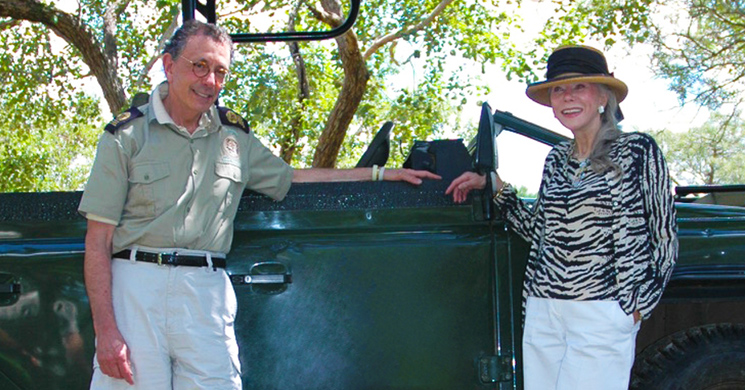When Heidi and Allen Roberts first arrived at the Hoedspruit Endangered Species Centre (HESC) in South Africa on safari, they assumed they’d leave with a few pleasant memories and, hopefully, a collection of priceless photographs of rhinos, elephants and cheetahs. Instead, they departed with a mission that continues to this day: to further the center’s work protecting African wildlife and educating the local and global community about wildlife conservation. Over the last 11 years the pair’s nonprofit, U.S. Friends of HESC, has raised nearly $2 million to that end.
If the funds Allen and Heidi have been able to provide the HESC are impressive, so, too, is their primary means of fundraising. The couple hosts numerous dinner parties each year at their New York City home, with Heidi preparing the meal herself and friends and supporters paying to attend. We recently spoke to Heidi and Allen about the impact of their nonprofit efforts, why they’re so passionate about the HESC and how they manage to host dozens of guests to support this cause.
What inspired you to start the U.S. Friends of HESC?
We looked at the endangered animals housed at the center, temporarily or for the rest of their lives, and realized that survival of some entire species is fragile. The benefits of cheetah breeding and release back to the wild caught our attention immediately, but we were alarmed by escalating poaching that has become devastating to rhinos and other species. We knew we had to do something. After our first visit, we told the founder of HESC, Lente Roode, we’d like to make a donation, but she didn’t have a U.S. presence we could direct those funds toward. So we helped by setting up the nonprofit.
Your U.S. nonprofit supports the HESC. What are some of the HESC’s main activities?
The center provides a safe haven for rescued and orphaned animals and researches endangered species for nutrition and genetics. Also, we’re trying, as best we can, to make people aware of the importance of wildlife conservation. There are 1,000 students who come to the center each month. The center staff gives them a tour and educational materials teaching about the animals. The goal is to make sure they understand it’s in their interest to preserve these animals.
What impact does the HESC have on its local community in South Africa?
Beyond the public awareness and educational outreach, the HESC employs 65 people at the center alone. It sponsors local students, paying to train them into jobs at the HESC while they’re still in high school. There is no public transportation, so they send a taxi into the townships to pick them up and bring them here for training. HESC also has collaborated with Icahn School of Medicine at Mount Sinai to house and transport fellows who work at a nearby community health clinic for an HIV treatment and prevention program. The center is not just doing work for the animals, but for the people too.
What types of projects has the U.S. Friends of HESC fundraising supported?
A lot of the funds go to important, if totally mundane, things. For example, our fundraising paid for a well and water system to get water flowing to the animals at the center property. The elephants in herds surrounding the center know where the water is and they had destroyed the original pipes. We help the center pay for its upkeep, as well. We funded the installation and repair of the center’s protective electrical fencing. We supported the training of a community member who now heads up the center’s anti-poaching efforts with a mature trained dog and a puppy who is learning to protect the animals at the center.
Is the center’s work helping to reduce animal poaching in the area?
I cannot tell you that definitively, but I truly hope so. I think so long as there are people who are willing to spend large amounts of money for, say, ground-up rhino horn, you’ll have poachers willing to go after them. That’s why it’s so vital that the HESC keep reaching out to the schools, talking to students about the animals, and letting them take ownership and realize that’s their future. The center helps the children see the many aspects of the beauty of the animals — they even make drawings of them that the center sells in its gift shop. In starting U.S. Friends of HESC to support the center, we hoped these children, and even their children, will still be able to see animals in the wild when they’re grown, not just in a zoo.
What’s your approach to your nonprofit fundraising?
I am involved with other nonprofits, and what I have learned is that there’s often a lot of money devoted to fundraising and administration. Our model is different because it is so personal. By holding 14 dinner parties with a silent auction, we raised $270,000 last year. But our expenses were only $1,625 — $125 is a New York State filing fee, and $1,500 was for an accountant to file our taxes. One of our board members who owns gourmet markets donates the food; we have friends in the wine, spirits and beer businesses who donate the beverages. This is something I can do on my own — I can create an intimate event, and 24 guests each evening pay to attend.
Lastly, how do you cook for so many parties?
It developed quite naturally. We entertain at home very frequently. But two weeks every year are devoted to U.S. Friends of HESC. To keep it simple, I prepare the same menu every night: caviar and eggs in the shell, soup, roast duck with wild rice, and opera cake. As hosts, that means we don’t have much variety in our activity or menu for two weeks of every year — but we know it is one way we can help make a difference!The information in this article is presented as-is.
©2017 First Republic Bank




